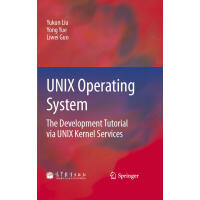1 Background of UNIX Operating System
1.1 Introduction of Operating System
1.2 Types of UNIX
1.3 History of UNIX
1.4 Summary
Problems
References
2 How to Start
2.1 UNIX Software Architecture
2.1.1 UNIX Kernel
2.1.2 System Call Interface
2.1.3 Standard Libraries and Language Libraries
2.1.4 UNIX Shell
2.1.5 Applications
2.2 UNIX Environment
2.3 Character User Interface Versus Graphical User Interface.
2.4 UNIX Command Lines
2.4.1 UNIX Command Syntax
2.4.2 Directory Operation Commands
2.4.3 File Operation Commands
2.4.4 Displaying Online Help
2.4.5 General Utility Commands
2.4.6 Summary for Useful Common Commands
2.5 UNIX Window Systems
2.5.1 Starting X
2.5.2 Working with a Mouse and Windows
2.5.3 Terminal Window
2.5.4 Using a Mouse in Terminal Windows
2.6 Shell Setup Files
2.7 Summary
Problems
References
3 Text Editors
3.1 Difference Between Text Editors and Word Processors
3.2 Introduction of Pico Editor
3.2.1 Start pico, Save File, Exit pico
3.2.2 Create a New File with Pico
3.2.3 Cursor-moving Commands in Pieo
3.2.4 General Keystroke Commands in Pico
3.3 The vi Editor and Modes
3.3.1 Three Modes of the vi and Switch Between Them ~ ~ ~
3.3.2 Start vi, Create a File, Exit vi
3.3.3 Syntax of the vi Commands
3.4 Practicing in Insert Mode of the vi Editor
3.5 Practicing in Command Mode and Last Line Mode of the viEditor
3.6 Using Buffers of the vi Editor
3.7 The vi Environment Setting
3.8 Introduction of the emacs Editor
3.8.1 Start emacs, Create File, Exit emacs
3.8.2 Buffers, Mark and Region in emacs
3.8.3 Cursor Movement Commands
3.8.4 Keyboard Macros
3.8.5 Search and Replace
3.8.6 Operation Example
3.8.7 Programming in emacs
3.9 Summary
Problems
References
4 UNIX Process Management
4.1 Multiple Processes' Running Concurrently
4.1.1 Pundamental Concept for Scheduler and SchedulingAlgorithm
4.1.2 UNIX Scheduling Algorithm and Context Switch
4.2 Process States
……

